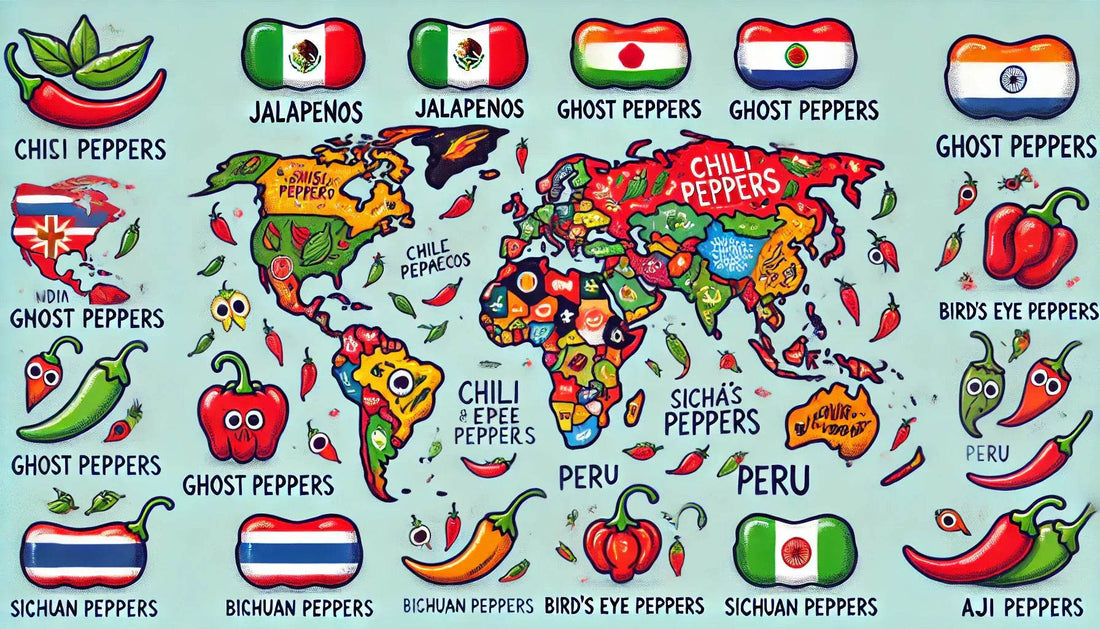
Where Do Spicy Peppers Come From?
Where Do Spicy Peppers Come From?
The World's Leading Spicy Pepper Producer: A Deep Dive into the Top Spicy Pepper-Producing Country
When it comes to spicy peppers, one country reigns supreme in terms of production: India. Known for its diverse chili varieties and deep-rooted spice culture, India is the largest producer of spicy peppers globally. This dominance is driven by favorable climate conditions, extensive agricultural practices, and an increasing demand for both domestic consumption and international exports.
India’s Spicy Pepper Production: A Look at the Numbers
India is by far the largest producer of spicy peppers, contributing a significant portion of the global supply. According to the Food and Agriculture Organization (FAO), India produces over 1.8 million metric tons of chili peppers annually, making up a large share of the world's total spicy pepper production. This staggering figure includes a variety of chilies, from the moderately hot Kashmiri chilies to the infamous Bhut Jolokia (Ghost Pepper), once ranked as the world’s hottest pepper.
Why is India the Leading Producer?
Several key factors contribute to India’s dominance in spicy pepper production:
1. Climate and Geography
India’s diverse climate allows for year-round pepper cultivation. States like Andhra Pradesh, Telangana, Karnataka, Tamil Nadu, and Maharashtra are known for their large-scale chili farming. These regions have the perfect blend of hot temperatures and fertile soil required for chili cultivation.
2. Large-Scale Agricultural Practices
India’s extensive agricultural sector benefits from both traditional and modern farming techniques. Farmers use greenhouse cultivation, hybrid seed development, and efficient irrigation systems to maximize yields.
3. High Domestic Demand
Spicy food is an integral part of Indian cuisine. From fiery curries to masalas, chilies are a staple ingredient. This high domestic demand ensures a stable market for chili farmers.
4. Global Export Market
India is the world’s largest exporter of dried chili peppers and chili powder. Indian chilies are shipped worldwide, with major markets in the United States, China, Thailand, Sri Lanka, and Bangladesh. The popularity of Indian spices has led to an ever-growing international demand for its chili peppers.
Other Top Spicy Pepper-Producing Countries
While India holds the top spot, other countries also play significant roles in global spicy pepper production:
- China: Although better known for overall pepper production, China also produces a vast amount of hot peppers, particularly in provinces like Sichuan and Hunan, where spicy food is a staple.
- Mexico: Famous for its vast variety of chili peppers, including habaneros, jalapeños, and serranos, Mexico is a major producer of hot peppers.
- Thailand: Thai cuisine is renowned for its heat, and the country produces many spicy chili varieties like Bird’s Eye chili.
- Bangladesh: Another key player in the production of hot chilies, Bangladesh is known for growing the potent Naga Morich pepper.
The Economic Impact of Spicy Pepper Production
India’s chili pepper industry is not just about agriculture—it’s an economic powerhouse. The industry supports millions of farmers and workers involved in harvesting, processing, and exporting. With the increasing global appetite for spicy food, India’s position as the top producer remains strong and lucrative.
Final Thoughts
Spicy peppers are more than just a kitchen ingredient—they represent a massive global industry, with India leading the way in production. With a combination of ideal growing conditions, advanced farming techniques, and a deep-rooted culinary tradition, India has cemented itself as the world's spicy pepper capital. As demand for fiery flavors continues to rise, India’s role in supplying the world’s hottest chilies will only strengthen. Whether you're enjoying a scorching hot curry or adding a kick to your favorite dish, there’s a good chance that the fiery heat in your meal comes from India—the undisputed leader in spicy pepper production.








